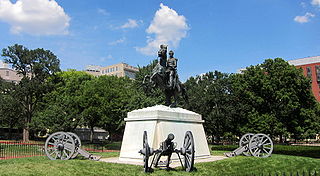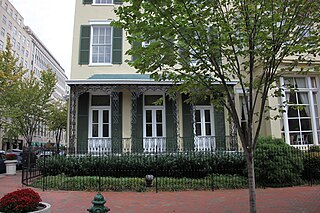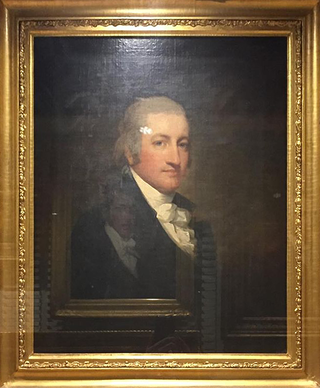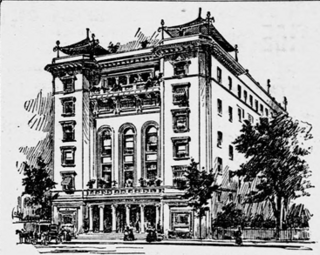
William Thornton was an American physician, inventor, painter and architect who designed the United States Capitol. He also served as the first Architect of the Capitol and first Superintendent of the United States Patent Office.

The Willard InterContinental Washington, commonly known as the Willard Hotel, is a historic luxury Beaux-Arts hotel located at 1401 Pennsylvania Avenue NW in Downtown Washington, D.C. It is currently a member of Historic Hotels of America, the official program of the National Trust for Historic Preservation. Among its facilities are numerous luxurious guest rooms, several restaurants, the famed Round Robin Bar, the Peacock Alley series of luxury shops, and voluminous function rooms. Owned jointly by Carr Companies and InterContinental Hotels & Resorts, it is two blocks east of the White House, and two blocks west of the Metro Center station of the Washington Metro.

The Embassy of Ukraine in Washington, D.C., is the diplomatic mission of Ukraine to the United States. The embassy is located at 3350 M Street NW, in the heart of Georgetown's commercial district.

St. John's Episcopal Church, Lafayette Square is a historic Episcopal church located at Sixteenth Street and H Street NW, in Washington, D.C., along Black Lives Matter Plaza. The Greek Revival building, designed by Benjamin Henry Latrobe, is adjacent to Lafayette Square, one block from the White House. It is often called the "Church of the Presidents".

Petworth is a neighborhood of Washington, D.C., located in Northwest D.C. While largely residential, Petworth is home to a notable commercial corridor of shops and restaurants, primarily along Georgia Avenue and Upshur Street, as well as a portion of 14th Street. The neighborhood is accessible via the Georgia Ave–Petworth station on the Green Line of the Washington Metro.

The Octagon House, also known as the Colonel John Tayloe III House, is a house located at 1799 New York Avenue, Northwest in the Foggy Bottom neighborhood of Washington, D.C. It was built in 1799 for John Tayloe III, the wealthiest planter in the country, at the behest of his new family member, George Washington. In September 1814, after British forces burnt the White House during the War of 1812, for six months the Octagon House served as the residence of United States president James Madison and first lady Dolley Madison. It is one of only five houses to serve as the presidential residence in the history of the United States of America, and one of only three, along with the White House and Blair House, that still stand.

Johannes Petrus "John Peter" Van Ness was an American politician who served as a U.S. Representative from New York from 1801 to 1803 and Mayor of Washington, D.C. from 1830 to 1834.

Founded in 1871, the Philosophical Society of Washington is the oldest scientific society in Washington, D.C. It continues today as PSW Science.

The Lafayette Square Historic District is a National Historic Landmark District in Washington, D.C., encompassing a portion of the original L'Enfant Plan for the city's core. It includes the 7-acre (2.8 ha) Lafayette Square portion of President's Park, all of the buildings facing it except the White House, and the buildings flanking the White House to the east and west. The district was designated a National Historic Landmark in 1970.

Madison Place is a one-block street located in northwest Washington, D.C., across from the White House. It forms the eastern border of Lafayette Square between Pennsylvania Avenue and H Street NW. Buildings on Madison Place include the Howard T. Markey National Courts Building, the Benjamin Ogle Tayloe House, the Cutts-Madison House, and the Freedman's Bank Building. The street is part of the Lafayette Square Historic District.

The Howard T. Markey National Courts Building is a courthouse in Washington, D.C., which houses the United States Court of Federal Claims and the United States Court of Appeals for the Federal Circuit. It is located at 717 Madison Place NW, east of Lafayette Square and north of the White House, and borders the Freedman's Bank Building to the south, Benjamin Ogle Tayloe House at 721 Madison Place NW, the former Cosmos Club building at 725 Madison Place NW, and the Cutts-Madison House at 1520 H Street NW.

Being the site of military battles, deadly duels, assassinations, untimely deaths, and other associated tragedies, there are a number of reportedly haunted locations in Washington, D.C., the capital city of the United States.

The Cutts–Madison House is an American colonial-style historic home, now used for offices located at 1520 H Street NW in Washington, D.C. The house is best known for being the residence of former First Lady Dolley Madison, who lived there from November 1837 until her death in July 1849.

The Benjamin Ogle Tayloe House is a Federal-style house located at 21 Madison Place NW in Washington, D.C., in the United States. The house is on the northeast corner of Madison Place NW and Pennsylvania Avenue NW, directly across the street from the White House and the Treasury Building. Built in 1828 by Benjamin Ogle Tayloe, son of Colonel John Tayloe III, the house became a salon for politically powerful people in the federal government.

Benjamin "Ogle" Tayloe was an American businessman, bon vivant, diplomat, scion of colonial tidewater gentry, and influential political activist in Washington, D.C. during the first half of the 19th century. Although he never held elective office, he was a prominent Whig and influential in presidential electoral politics in the 1840s and 1850s. His home, the Tayloe House, became a salon for politically powerful people in the federal government and socially influential individuals in the United States and abroad. Tayloe was also a party in the important 1869 contract law case, Willard v. Tayloe, 75 U.S. 557.

John Tayloe III, of Richmond County, Virginia, was the premier Virginia planter; a politician, businessman, and tidewater gentry scion. He was prominent in elite social circles. A highly successful planter and early Thoroughbred horse breeder, he was considered the "wealthiest man of his day". A military officer, he also served in the Virginia House of Delegates and Senate of Virginia for nine years.

The University Club of Washington, D.C., is an American private club in downtown Washington, D.C., United States.

The Lafayette Square Opera House was an opera house built in 1895, at 717 Madison Place, NW in Washington D.C. It was dedicated on 30 September 1895 by Lillian Russell, one of the most well known actresses of the time, who was there to perform in Tzigane. Reginald De Koven, composer of the opera, led the orchestra at Russell's request. In 1905 it was purchased by the Shuberts and David Belasco and was renamed the Belasco Theatre. The theatre was acquired by the US federal government and used as a warehouse until World War II, when it was operated by the American Theatre Wing as a Stage Door Canteen. During the Korean War, it was used by the United Services Organization to entertain troops. The theater was razed in 1964.

The Freedman's Bank Building, previously known as the Treasury Annex, is a historic office building located on the corner of Madison Place and Pennsylvania Avenue NW in Washington, D.C. It sits on the east side of Lafayette Square, a public park on the north side of the White House, and across from the Treasury Building. The adjoining properties include the Howard T. Markey National Courts Building to the north and the former Riggs National Bank to the east.


























